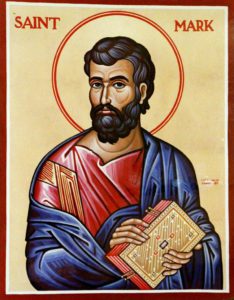
How often do we hear the very familiar words announcing the Gospel according to Mark? Mark’s Gospel was probably written between 65-70 CE and provided both Matthew and Luke with sources for their Gospels. Do we ever wonder who Mark was and how tradition arrived at his designation as an Evangelist? Other Gospels are attributed to an Apostle, so who was he?
Once we begin asking these kinds of questions, other questions emerge. Those early Christians who could read had some writings available to them, including the Jewish scriptures. But the canon of twenty-seven New Testament books was not formally decided by the Church until much later at the Council of Nicaea (325). So where did Mark’s Gospel come from?
We read in Luke 10 that there were “Seventy Disciples” whom Jesus sent to preach the good news. We can infer that there were many people telling the stories of what they knew about Jesus, probably including Luke and Mark. Talk about controversies in the Church today! This motivation to preach the Word drove the early Christians to seek the Truth. We could go off on a tangent here and get into all the arguments and contradictions that had to be dealt with in seeking the Truth. But for these few minutes on his feast, we will talk about Mark.
We hear his name connected to Paul and Barnabas, but many scholars agree that his closest association was with Peter who took Mark as a travel companion and interpreter (Acts 12:12; 15:37), and who likely wrote down Peter’s preaching, thus composing a collection of stories and sermons. In a way, the Gospel of Mark owes much of its contents to Peter’s accounts. However, Mark has his own style of writing, and his short gospel is considered to be the first one written of the four canonical gospels.
When read as one narrative, it is as if he is hurrying to get it written. We can look at just a few things Mark intended for us to know about Jesus. One of his major themes is PROMISE, which begins with the announcement by John the Baptist, echoing the prophets, who says that the Messiah is coming . . . and he is already here! Do we not begin Advent also with a sense of hope and promise?
Then Mark rushes to tell us about the call of the disciples and the miracles they witnessed. He wants us to know how Jesus taught in parables so that all might understand that the Kingdom of God is for all people.
Mark never lets us forget that Jesus was human, and he portrays the feelings of Jesus, such as sympathy, anger, and a deep love of friends, just to name a few. But his primary message is that God is true to his promises and sent His only Son, who upon completing his mission promised that the Holy Spirit would follow and teach them all things.
We remember that it was Mark who recalls the story of the women who went to the tomb and found it empty. They saw and heard the message from an angel who said:
Do not be amazed! You seek Jesus of Nazareth, the crucified. He has been raised; he is not here. Behold, the place where they laid him. But go and tell his disciples and Peter, ‘He is going before you to Galilee; there you will see him, as he told you.’ (Mark 16:7-8)
Although the women were seized with trembling, they told Peter and his companions what they had seen and heard.
We are the beneficiaries of Mark’s reflections and Jesus’ commissioning to go out to all the world and proclaim the Gospel to every creature. According to the Coptic and Greek Orthodox traditions, Mark traveled to Alexandria around 49 CE and became the bishop there. Through Mark and the disciples of Jesus, the sacred and imperishable proclamation of eternal salvation is extended today from East to West.
– Sister Bridget Kiniry, OP
A resident of Dominican Convent, Sister Bridget is a preacher and
coordinator of the Days for Girls program there.
